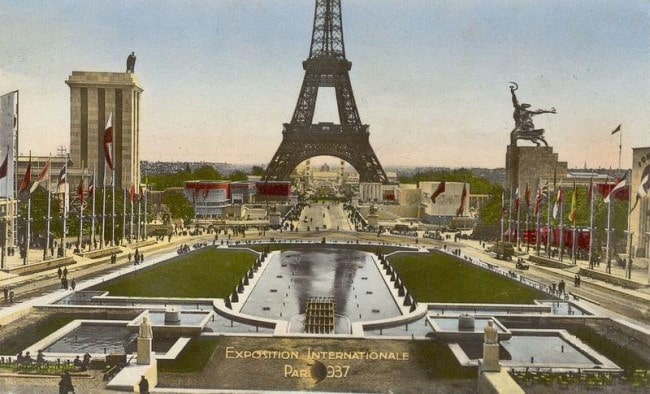The Paris Library: A Novel by Janet Skeslien Charles
Paris in 1939 (C) Unknown author, Public Domain Odile and Lily are drawn to each other through their love of books. At one point in the story Lily has come over to Odile’s house, feeling out of place in her own, and seeking comfort. She and Odile come up with the idea of creating their own shelf of favorite books. (“Some favorites were Le Petit Prince, Little Women, The Secret Garden, Candide, The Long Winter, A Tree Grows in Brooklyn, Their Eyes Were Watching God. When we finished, I felt like no matter what happened, I’d always have a place with Odile,” Lily says.) Book lovers will recognize the joy that such a friendship — between two people who love nothing more than talking about books, and who find that they have favorites in common — can bring. There are many such passages in this book, and the book is also liberally sprinkled with the names of beloved books, as well as quotes from books, each mention of which will bring a smile to the lips of book lovers.
Book club (C) Hatice Yardım, Unsplash
Americans have not always had the best reputation in France (and indeed in many other places), and often we have not deserved one. But there are many moments and people, events and institutions in our history that any American can, and should, feel proud of. One of the latter is the history of the American Library in Paris, which was founded in 1920, and continues today to be a rich cultural resource, sharing books, intelligent discourse, and communication among and between people — and not just Americans — who love these things.
The Paris Library: A Novel by Janet Skeslien Charles is a historical novel based on real people and true incidents at the American Library in Paris during the Occupation of Paris in the Second World War. It is also a story about books, book lovers, and libraries. Therefore, anyone who loves historical fiction, especially about WWII, as well as anyone who is, or who has ever been, a bookworm, is probably going to love this book.
The novel tells an elegantly interwoven story that switches back and forth between two times and places: it begins in Paris in 1939, and ends (kind of) in Montana in 1988. At the center of the story are two booklovers: Odile, an elderly Frenchwoman living in a small town in Montana, and her adolescent next-door neighbor, Lily, who is grappling with the pain of losing her mother to cancer, and the even more difficult transition required of her when her father remarries within a very short time and starts a new family.

Paris in 1939 (C) Unknown author, Public Domain
Odile and Lily are drawn to each other through their love of books. At one point in the story Lily has come over to Odile’s house, feeling out of place in her own, and seeking comfort. She and Odile come up with the idea of creating their own shelf of favorite books. (“Some favorites were Le Petit Prince, Little Women, The Secret Garden, Candide, The Long Winter, A Tree Grows in Brooklyn, Their Eyes Were Watching God. When we finished, I felt like no matter what happened, I’d always have a place with Odile,” Lily says.) Book lovers will recognize the joy that such a friendship — between two people who love nothing more than talking about books, and who find that they have favorites in common — can bring. There are many such passages in this book, and the book is also liberally sprinkled with the names of beloved books, as well as quotes from books, each mention of which will bring a smile to the lips of book lovers.

Book club (C) Hatice Yardım, Unsplash
The Paris Library is also a rich human story about many other things, perhaps most importantly about friendship, human complexity, and the importance of tolerance and forgiveness between human beings, all of whom are so woefully imperfect. (“Accept people for who they are, not for who you want them to be. Try to put yourself in their shoes” is a key phrase, and because it is key, it occurs several times.) It’s not a bad theme to repeat. In the course of the story, both Odile and Lily are forced to accept, often grudgingly, the imperfection of others, sometimes those they love, in addition to facing their own imperfections. And it seems that the lesson of tolerance and understanding they learn through hard experience has to be learned more than once. Once is just not enough.

Librarian (C) Angelina Yan, Unsplash
The story takes Odile from the time she is a young woman who has gotten her dream job as a librarian at the American Library, through a variety of difficult experiences during the years of the Occupation. Through it all the library, and the cast of characters there (several of whom are real-life American librarian heroes) keeps her — and many others — going, in a fundamental way. The auxiliary characters are well drawn and often amusing, and many of them are also based on real figures whom the author was able to learn about through her extensive research. She also works the American Hospital of Paris, another institution of which Americans can be very proud, into the story.
I think it is worth drawing attention to one of the crucial activities at the center of the story, which is the (true, and historical, and brave!) effort made by the librarians at the American Library to hand deliver books to their Jewish subscribers after the subscribers themselves were no longer allowed to visit the library. It’s also worth mentioning a scene in which Odile is asked about the library’s project of sending books to French troops before America entered the war. “Are the French so interested in American books?” one journalist asks. “And do soldiers have time to read?” When Odile answers in the affirmative, and adds that the purpose of sending the books is to raise morale, another reporter quips, “Then why not send wine?” She responds, “Why books? Because no other thing possesses that mystical faculty to make people see with other people’s eyes. The Library is a bridge of books between cultures.” (The author explains in her Author’s Note that this actually is a quote from the real Dorothy Reeder, who was director of the library at the time.)
I will admit that especially in the beginning of the book my editor’s hand was itching to make just a tiny change here or there. But as I got into the story, that impulse went away and I was swept up both by the passion and the drama of the fictional story, and fascination with the true story on which it is based. I was also absorbed with a kind of sober re-recognition of all that people went through during those years, to fight in every way they could the hatred and evil surrounding them. To say it wasn’t easy is a gross understatement.
And so, reading such a story one of the things I felt — in addition to admiration for the courage and selflessness so many found within themselves during those terrible years — was an unavoidable concern about what could certainly happen again, and what we would all need to do in order to fight it. And to reflect on what the personal costs might be.
Since the world seems to be once again witnessing a worrisome rise of intolerance and lack of understanding between people not only across cultures but also within them, it seems to me that the real end of this book is in the Author’s Note, which I believe everyone should read.
A friend said she believes that in reading stories set in World War II, people like to ask themselves what they would have done. I think a better question to ask is what we can do now to ensure that libraries and learning are accessible to all and that we treat people with dignity and compassion.
Lead photo credit : The Paris Library
Janet Skeslien Charles (C) Janet Skeslien Charles
Source :bonjourparis.com
